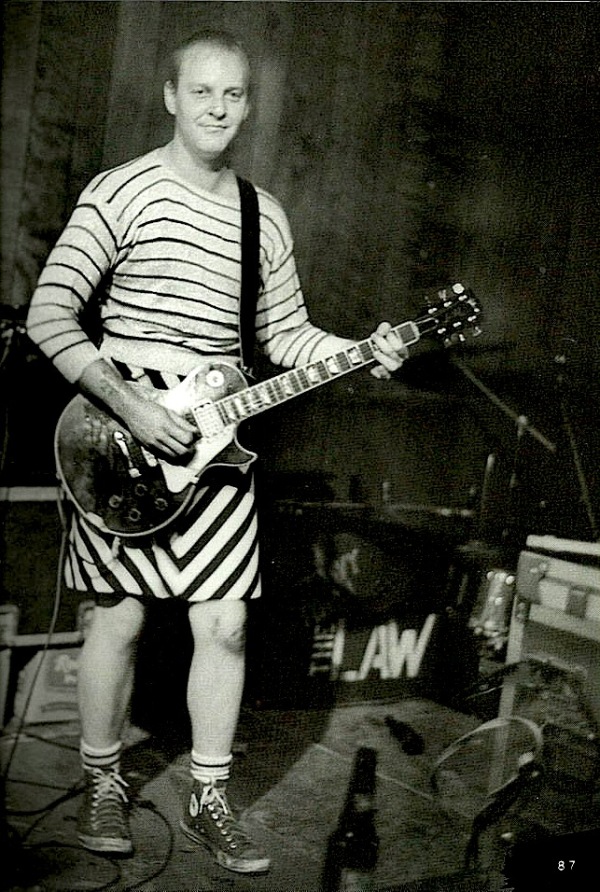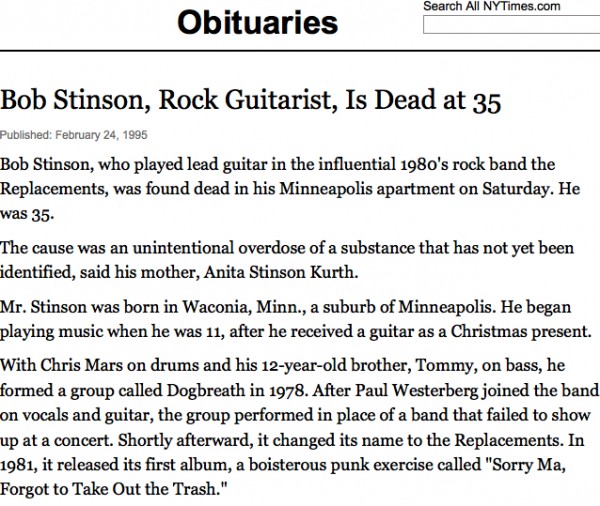EDITOR’S NOTE: In honor of the re-activated Replacements playing the Festival Pier on Saturday, we’re re-running Mats Week. Look for Replacements lore and legend all week on a Phawker near you!
 BY JONATHAN VALANIA The Replacements were made to be broken, and it’s a minor miracle they lasted eight albums, spread out over the course of a lost decade. In the end, the dream got too tired to come true, but for a brief and shining moment, it seemed like anything was possible. “For a while there, Paul had no idea how good a songwriter he was,” says Jesperson. “I always said I wanted to work with people who were better than they thought they were. There were nights when it was incomprehensible to me that there was a better band on the planet.” But there were just as many nights when the shows would devolve into drunken disasters, even by the most charitable standards of professionalism — sometimes by accident, sometimes by the bottle, sometimes by intent and sometimes all of the above. It started as a mistake but soon became a way of deflating expectations. After a while, it became a shtick, a showbiz hook: Come watch them shoot another toe off! There’s only one left! And then people came to watch them self-destruct. “Some of that Replacements stuff was jive, that sort of ‘Duh, I don’t know how to play’ stuff,” says Westerberg. “For us, it was all or nothing. We were either going to be the greatest band on earth or the worst. Settling for just being a good band was not an option. People like to see human error when it’s honest. When people see you swing and miss, they start to root for you.”
BY JONATHAN VALANIA The Replacements were made to be broken, and it’s a minor miracle they lasted eight albums, spread out over the course of a lost decade. In the end, the dream got too tired to come true, but for a brief and shining moment, it seemed like anything was possible. “For a while there, Paul had no idea how good a songwriter he was,” says Jesperson. “I always said I wanted to work with people who were better than they thought they were. There were nights when it was incomprehensible to me that there was a better band on the planet.” But there were just as many nights when the shows would devolve into drunken disasters, even by the most charitable standards of professionalism — sometimes by accident, sometimes by the bottle, sometimes by intent and sometimes all of the above. It started as a mistake but soon became a way of deflating expectations. After a while, it became a shtick, a showbiz hook: Come watch them shoot another toe off! There’s only one left! And then people came to watch them self-destruct. “Some of that Replacements stuff was jive, that sort of ‘Duh, I don’t know how to play’ stuff,” says Westerberg. “For us, it was all or nothing. We were either going to be the greatest band on earth or the worst. Settling for just being a good band was not an option. People like to see human error when it’s honest. When people see you swing and miss, they start to root for you.”
And so the Replacements became the underground’s beloved underdogs, boozy everymen, churning out anthems of hope and failure, wearing their hearts on the their flannel sleeves. Fans jokingly referred to the group as the Replacemats, which was soon shortened to The’Mats, which is what you called them if you were in on the joke. […] After a few willfully disastrous label showcases in New York — including an especially drunk and belligerent CBGB gig — the Mats eventually signed with Sire. “We were afraid of what they were going to do to us, with good reason,” says Westerberg. “We knew it was the end of something, but we had to move on because what had come before had exhausted itself. I believe it was my songs and Tommy’s looks that (Sire president) Seymour Stein thought he could take to the bank.”
For their major-label debut, 1985’s Tim, the Mats chose former Ramones drummer Tommy Erdelyi to produce. Unbeknownst to the band, Erdelyi was going deaf, and Tim  kind of sounds like it. Sonic shortcomings aside, Tim contains some of Westerberg’s most accomplished songs: “Here Comes A Regular,” “Left Of The Dial” and the anthemic “Bastards Of Young,” which spawned one of the most bizarre videos to be aired on MTV during the ‘80s. Part Andy Warhol’s Empire and part middle finger to its major label, the black-and-white video features a single shot of a throbbing stereo speaker. Ultimately, Tim neither satisfied the hard-line Mats fans (who thought it was too polished), nor did it succeed commercially, peaking at number 51 on the Billboard charts.
kind of sounds like it. Sonic shortcomings aside, Tim contains some of Westerberg’s most accomplished songs: “Here Comes A Regular,” “Left Of The Dial” and the anthemic “Bastards Of Young,” which spawned one of the most bizarre videos to be aired on MTV during the ‘80s. Part Andy Warhol’s Empire and part middle finger to its major label, the black-and-white video features a single shot of a throbbing stereo speaker. Ultimately, Tim neither satisfied the hard-line Mats fans (who thought it was too polished), nor did it succeed commercially, peaking at number 51 on the Billboard charts.
“I did all the guitar playing (on Tim), and one of the speakers on my amp was blown, and I think that was the one that the microphone was on,” says Westerberg. “By this point, Bob had pretty much lost interest, and we didn’t really do much to encourage his participation.” The guitarist had been slowly slipping away from the band since the making of Let It Be. “Bob just got out of hand,” says Westerberg. “He would be outside in the alley trying to score drugs while we were onstage. When he was tipsy and wearing a dress, he was charming, but when he was just wasted, stark naked and had no clue at 180 decibels, it was like, ‘This ain’t helping us at all.’” Stinson tried rehab a handful of times — often on the band’s dime — and it would occasionally work, at least for a few days.
Our Band Could Be Your Life, critic Michael Azerrad’s recent book about the American underground-rock scene in the ‘80s, devotes a chapter to the Replacements, wherein Bob Stinson’s then-wife Carleen accuses Westerberg of shoving a bottle of champagne in Stinson’s face during one of the guitarist’s sober periods and giving him an ultimatum: “Either take a drink, motherfucker, or get off my stage.” I mention the book to Westerberg. “Yeah, I might have skimmed it,” he says, and before I can bring up the particular incident, he cuts me off: “You mean page 229? The key phrase is her saying, ‘It’s the only time I ever saw Bob cry.’ Well, I saw Bob cry 96 times — I think that says a lot about his relationship with that woman. I’ve said this before: It wasn’t the liquor that tore the band apart, it was the women.”
A few weeks after the incident in question, Stinson was fired, and in the hearts of most charter Mats fans, this was effectively the end of the group. Stinson would go on to achieve local bar-band glory with Static Taxi and the Bleeding Hearts, generally having a good time all the time. He died in 1995, at the age of 35. “I heard the coroner’s report said, ‘He wore himself out,’” says Westerberg. “I saw Bob two nights before he died. I was returning a video, and he was on his way to the liquor store. He gave me this look like, ‘You wanna come with us? We’re going back to my place to get high.’ I was sober by that point, but for a second, I almost went with him. It was sad, but you knew it was coming. From the day I met him, he spent his days getting fucked up. That never changed. I really loved the son of a bitch. Any time he asked me to buy him a drink I would empty my pockets for him. But I didn’t like his guitar playing. I wanted to get rid of him from day one.” MORE
***
RELATED: HOLD MY LIFE: Bob Stinson’s Regrets
RELATED: The Final Days Of Bob Stinson


